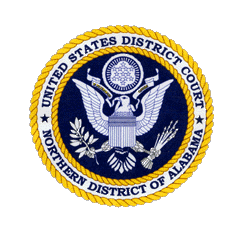Top Qs
Timeline
Chat
Perspective
United States District Court for the Northern District of Alabama
Federal court of the 11th circuit From Wikipedia, the free encyclopedia
Remove ads
The United States District Court for the Northern District of Alabama (in case citations, N.D. Ala.) is a federal court in the Eleventh Circuit (except for patent claims and claims against the U.S. government under the Tucker Act, which are appealed to the Federal Circuit).
The District was established on March 10, 1824, with the division of the state into a Northern and Southern district. The circuit court itself was established on June 22, 1874.[1]
The United States Attorney's Office for the Northern District of Alabama represents the United States in civil and criminal litigation in the court. The United States attorney is Prim F. Escalona, who was appointed by United States Attorney General William Barr following the resignation of Jay Town on July 15, 2020.[2]
Remove ads
Organization of the court
The United States District Court for the Northern District of Alabama is one of three federal judicial districts in Alabama.[3] Court for the District is held at Anniston, Birmingham, Florence, Huntsville, and Tuscaloosa.
Northwestern Division comprises the following counties: Colbert, Franklin, Lauderdale, and Lawrence.
Northeastern Division comprises the following counties: Cullman, Jackson, Limestone, Madison, Marshall, and Morgan.
Southern Division comprises the following counties: Blount, Jefferson, and Shelby.
Eastern Division comprises the following counties: Calhoun, Cherokee, Clay, Cleburne, DeKalb, Etowah, St. Clair, and Talladega.
Western Division comprises the following counties: Bibb, Fayette, Greene, Lamar, Marion, Pickens, Sumter, Tuscaloosa, Walker, and Winston.
Remove ads
Current judges
As of January 2, 2025[update]:
Remove ads
Vacancies and pending nominations
Former judges
- Reassigned from the District of Alabama.
- Recess appointment; formally nominated on January 23, 1860, confirmed by the United States Senate on January 30, 1860, and received commission the same day.
- Recess appointment; formally nominated on January 5, 1864, confirmed by the Senate on January 20, 1864, and received commission the same day.
- Recess appointment; formally nominated on December 5, 1901, confirmed by the Senate on December 17, 1901, and received commission the same day.
- Received a second recess appointment and was again rejected by the Senate.
- Received a third recess appointment but resigned prior to consideration.
- Recess appointment; formally nominated on January 6, 1936, confirmed by the Senate on January 22, 1936, and received commission on January 28, 1936.
- Recess appointment; formally nominated on January 15, 1962, confirmed by the Senate on February 5, 1962, and received commission on February 9, 1962.
Remove ads
Chief judges
Chief judges have administrative responsibilities with respect to their district court. Unlike the Supreme Court, where one justice is specifically nominated to be chief, the office of chief judge rotates among the district court judges. To be chief, a judge must have been in active service on the court for at least one year, be under the age of 65, and have not previously served as chief judge.
A vacancy is filled by the judge highest in seniority among the group of qualified judges. The chief judge serves for a term of seven years, or until age 70, whichever occurs first. The age restrictions are waived if no members of the court would otherwise be qualified for the position.
When the office was created in 1948, the chief judge was the longest-serving judge who had not elected to retire, on what has since 1958 been known as senior status, or declined to serve as chief judge. After August 6, 1959, judges could not become or remain chief after turning 70 years old. The current rules have been in operation since October 1, 1982.
Remove ads
Succession of seats
Summarize
Perspective
Remove ads
Court decisions
Summarize
Perspective
Lucy v. Adams (1955) – A court ruling which affirmed the right of all citizens to be accepted at the University of Alabama. The U.S. Supreme Court upheld the ruling.
Armstrong v. Birmingham Board of Education (1963) – The court dismissed the plaintiff's complaint. On appeal, the Fifth Circuit reversed and ordered the desegregation of Birmingham public schools.[4]
United States v. Wallace (1963) – The court exercised its ruling in Lucy v. Adams and ordered that colored students be permitted to enroll at the University of Alabama in Tuscaloosa. The court order led to the infamous Stand in the Schoolhouse Door incident with Governor George C. Wallace.[5]
Jackson v. Birmingham Board of Education (2002) – A reversal of the decision rendered by the district and Eleventh Circuit. The U.S. Supreme Court held that retaliation against a person on the basis of a sexual complaint is a form of sexual discrimination under Title IX.
Ledbetter v. Goodyear Tire & Rubber Co. (2003) – The U.S. Supreme Court reversed the decision of the district court, stating that employers cannot be sued under Title VII of the Civil Rights Act over race or gender discrimination if the claims are based on decisions over 180 days. The decision of the court led Congress to pass the Lilly Ledbetter Fair Pay Act in 2009.
United States v. Alabama (2011) – The court upheld most parts of Alabama HB 56, an anti-illegal immigration bill signed by Governor Robert J. Bentley. The Eleventh Circuit reversed, invalidating much of Alabama HB 56.[6]
Remove ads
U.S. attorneys
Remove ads
See also
Notes
External links
Wikiwand - on
Seamless Wikipedia browsing. On steroids.
Remove ads


